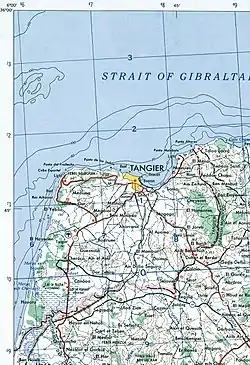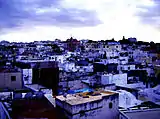Tangier International Zone
The Tangier International Zone (Arabic: منطقة طنجة الدولية Minṭaqat Ṭanja ad-Dawliyya, French: Zone internationale de Tanger, Spanish: Zona Internacional de Tánger) was a 373 km2 (144 sq mi) international zone centered on the city of Tangier, Morocco, then under French and Spanish protectorate, under the joint administration of France, Spain, and the United Kingdom (later Portugal, Italy, Belgium, the Netherlands, Sweden, and the United States), that existed from 1924 until its reintegration into independent Morocco in 1956.
Tangier International Zone منطقة طنجة الدولية Zone internationale de Tanger Zona Internacional de Tánger | |||||||||
|---|---|---|---|---|---|---|---|---|---|
| 1924–1956 | |||||||||
 Flag | |||||||||
 Map of Tangier and the International Zone | |||||||||
| Status | International Zone (Condominium) | ||||||||
| Capital | Tangier | ||||||||
| Common languages | French, Arabic, Berber, Portuguese, Haketia, Spanish, | ||||||||
| Religion | Islam, Christianity, Judaism | ||||||||
| Historical era | Interwar period | ||||||||
• Established | 1924 | ||||||||
• Spanish occupation | 14 June 1940 – 11 October 1945 | ||||||||
• Disestablished | 1956 | ||||||||
| Area | |||||||||
| 1924 | 373 km2 (144 sq mi) | ||||||||
| Population | |||||||||
• 1939 | 60,000 | ||||||||
• 1950 | 150,000 | ||||||||
| Currency | Pound sterling | ||||||||
| |||||||||
| Today part of | |||||||||
The zone was governed in accordance with the Tangier Protocol, although the Sultan of Morocco retained nominal sovereignty over the zone and jurisdiction over the native population.[1]
The international zone of Tangier had, by 1939, a population of about 60,000 inhabitants and 150,000 by 1950.
History
To solve a disagreement among France, Spain, and the United Kingdom over its control, Tangier was made a neutral demilitarised zone in 1924 under a joint administration according to an international convention signed in Paris on 18 December 1923.[2] Although some disagreements emerged about the agreement[3] ratifications were exchanged in Paris on 14 May 1924.[4] The convention was amended in 1928.[5] The governments of Italy, Portugal, and Belgium adhered to the convention in 1928, and the government of the Netherlands in 1929.

The Zone had its own appointed International Legislative Assembly, which was subject to supervision by a Committee of Control consisting of the Consuls of Belgium, France, Britain, Italy, the Netherlands, Portugal, and Spain.[6] Executive power was vested in an Administrator, and judicial power resided in a Mixed Court of five judges, respectively appointed by the Belgian, British, Spanish, French, and Italian governments.[6] As a result of the creation of the Mixed Court, the various European powers withdrew the consular courts that previously exercised jurisdiction there.[7]
The Zone had a reputation for tolerance, diversity of culture, religion, and bohemianism. It became a tourist hotspot for literary giants and gay men from Western countries. Many of the latter were able to live an openly "out" life in the Zone.[8][9]
Spanish troops occupied Tangier on 14 June 1940, the same day Paris fell to the Germans. Despite calls by the writer Rafael Sánchez Mazas and other Spanish nationalists to annex "Tánger español", the Francoist State publicly considered the occupation a temporary wartime measure.[10] A diplomatic dispute between Britain and Spain over the latter's abolition of the city's international institutions in November 1940 led to a further guarantee of British rights and a Spanish promise not to fortify the area.[11] Tangiers was annexed to the Spanish Protectorate of Morocco at 23 November 1940.[12] In May 1944, although it had served as a contact point between himself and the later Axis Powers during the Spanish Civil War, Franco expelled all German diplomats from the Zone.[13]
The territory was restored to its pre-war status on 11 October 1945.[14] In July 1952 the protecting powers met at Rabat to discuss the Zone's future, agreeing to abolish it. Tangier joined with the rest of Morocco following the restoration of full sovereignty in 1956.[15]
Administrators
| Administrator | Country | Term of Office | |
|---|---|---|---|
| Paul Alberge | 24 August 1926 – 19 August 1929 | ||
| Joseph Le Fur | 19 August 1929 – 1 August 1940 | ||
| Manuel Amieva Escandón | 1 August 1940 – 4 November 1940 | ||
Under Spanish occupation (4 November 1940 – 11 October 1945) | |||
| Luís Magalhães Correia | 11 October 1945 – 18 June 1948 | ||
| Henri van Vredenburch | 15 August 1948 – 9 April 1951 | ||
| José Luís Archer | 9 April 1951 – 22 June 1954 | ||
| Étienne-Gustave de Croÿ | 21 June 1954 – 31 December 1954 | ||
| Robert van de Kerchove d'Hallebast | 4 June 1955 – 9 July 1956 | ||
References
- Stahn 2008, pp. 57–58.
- Stahn 2008, p. 57.
- Stuart 1955, p. 80.
- "Convention regarding the Organisation of the Tangier Zone, with Protocol relating to Two Dahirs concerning the Administration of the Tangier Zone and the Organisation of International Jurisdiction at Tangier, signed at Paris, December 18, 1923 [1924] LNTSer 187; 28 LNTS 541". 1924.
- "Agreement revising the Convention of December 18, 1923, relating to the Organisation of the Statute of the Tangier Zone and Agreement, Special Provisions, Notes and Final Protocol relating thereto. Signed at Paris, July 25, 1928 [1929] LNTSer 68; 87 LNTS 211". 1928.
- Stuart 1945.
- Morocco (Tangier Zone) Order in Council, 1925, "No. 33050". The London Gazette. 26 May 1925. pp. 3547–3548.
- Hamilton, Richard (12 October 2014). "How Morocco was once a haven for gay Westerners". BBC News. Retrieved 2 September 2018.
- Bond, Gwenda (2007). "Seriously Gay and Lesbian". Publishers Weekly. 254 (19): 27–31. ISSN 0000-0019.
- Payne 1987, p. 268.
- Payne 1987, p. 274, note 28.
- BOE núm. 336, pp. 8250-8251 (1940)
- Beevor 2006, pp. 152, 464.
- "Reestablishment of the International Regime in Tangiers". Department of State Bulletin. Department of State. XIII (330): 613–618. 21 October 1945.
- "Final Declaration of the International Conference in Tangier and annexed Protocol. Signed at Tangier, on 29 October 1956 [1957] UNTSer 130; 263 UNTS 165". 1956.
Works cited
- Beevor, Antony (2006). The Battle for Spain: The Spanish Civil War 1936–1939. London: Weidenfeld & Nicolson. ISBN 0-29784832-1.
- Payne, Stanley G. (1987). The Franco Regime, 1936–1975. Madison: University of Wisconsin Press. ISBN 978-0-299-11070-3.
- Stahn, Carsten (2008). The Law and Practice of International Territorial Administration: Versailles to Iraq and Beyond. Cambridge: Cambridge University Press. ISBN 978-0-52187800-5.
- Stuart, Graham H. (July 1945). "The Future of Tangier". Foreign Affairs. Council on Foreign Relations. 23 (4).
- Stuart, Graham H. (1955). The International City of Tangier (2nd ed.). Stanford: Stanford University Press.
Further reading
- Finlayson, Iain (1992). Tangier: City of the Dream. HarperCollins. ISBN 0-00217857-5.
